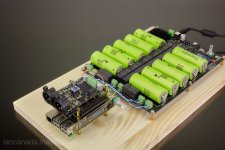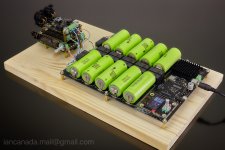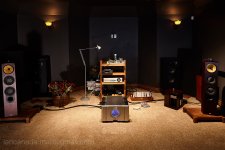My LofePO4 power supply is designed with all kinds of protection features to take care of the safety performance. Protections of over charge, over discharge, over time, cell balance, short current are all included. As well as relay contacts protection and so on. So, please no worry at all.
The real challenge was how to implement all of those safety features without impacting the sound quality at all. Fortunately I figured out the solutions.
Now, I'm working on test the sound quality. I'm very happy with the testing result so far. More update will be posted soon.
Regards,
Ian
Nice. Looking forward to this.
Hi Ian,
I admittedly have not read through the whole thread so please pardon me if this has been suggested previously (very, very interesting design idea BTW ;-)):
My suggestion would be to add some kind of adjustable timer so that the charging circuits may be switched off for a defined period of time only.
I personally only seriously listen to music for maybe 1-3 hours at a time and if there is a "charger on/off" button that is linked to a timer then the charger will come back on automatically should I forget to switch the charger on again after listening. It would be feasible if the timing period could be set e.g. in 15 minute intervals with a multiple switch (DIP type e.g.).
This way the batteries are only marginally discharged, most always fully charged when listening is desired, and battery life may be prolonged.
Cheers & subscribed ;-)
Jesper
I admittedly have not read through the whole thread so please pardon me if this has been suggested previously (very, very interesting design idea BTW ;-)):
My suggestion would be to add some kind of adjustable timer so that the charging circuits may be switched off for a defined period of time only.
I personally only seriously listen to music for maybe 1-3 hours at a time and if there is a "charger on/off" button that is linked to a timer then the charger will come back on automatically should I forget to switch the charger on again after listening. It would be feasible if the timing period could be set e.g. in 15 minute intervals with a multiple switch (DIP type e.g.).
This way the batteries are only marginally discharged, most always fully charged when listening is desired, and battery life may be prolonged.
Cheers & subscribed ;-)
Jesper
Have you considered over current and temperature control? Maybe someone has a problem with the design module, causing over current and the accompanying high temperatures.
Is there a protective way when the battery polarity is reversed?
These lifepo4 cells can put out a ton of current, 50A continuous per the datasheet. Pretty sure you have some serious problems if you're drawing 50A, and you'll smell smoke and burnt electronics.
I do believe in safety, but it needs to make sense. And I personally would rather a simpler circuit instead of an idiot proof one.
Randy
Hi Ian,
I admittedly have not read through the whole thread so please pardon me if this has been suggested previously (very, very interesting design idea BTW ;-)):
My suggestion would be to add some kind of adjustable timer so that the charging circuits may be switched off for a defined period of time only.
I personally only seriously listen to music for maybe 1-3 hours at a time and if there is a "charger on/off" button that is linked to a timer then the charger will come back on automatically should I forget to switch the charger on again after listening. It would be feasible if the timing period could be set e.g. in 15 minute intervals with a multiple switch (DIP type e.g.).
This way the batteries are only marginally discharged, most always fully charged when listening is desired, and battery life may be prolonged.
Cheers & subscribed ;-)
Jesper
Thanks Jesper,
That's a great idea. This kind of features have already been included in this LifePO4 power supply design.
If you listen to music for only two hours, normally the charge time will be 10 to 20 minutes. After that time, the charger will be stopped and goes into idle mode. The battery life will be extended comparing with charging it all the time.
The ending charge voltage is also under managed. If you just want to charge the cells to 3.35V, you can set it to. The charger will be stopped when the voltage level is reached. In this case, you can also set the sweet spot voltage according to your system and your preference on this power supply.
Regards,
Ian
Hi Ian,
All very interesting, indeed ;-) ...
Hmmm ... This is not what I have come to learn ... Do you have any references on this?
To my knowledge Lithium batteries do not really deteriorate being float charged if the voltage is correct (below a certain limit). Float charging the batteries will also allow the system to be powered on all the time which means that it will sound at its best.
Cheers,
Jesper
All very interesting, indeed ;-) ...
If you listen to music for only two hours, normally the charge time will be 10 to 20 minutes. After that time, the charger will be stopped and goes into idle mode. The battery life will be extended comparing with charging it all the time.
Hmmm ... This is not what I have come to learn ... Do you have any references on this?
To my knowledge Lithium batteries do not really deteriorate being float charged if the voltage is correct (below a certain limit). Float charging the batteries will also allow the system to be powered on all the time which means that it will sound at its best.
Cheers,
Jesper
Hi Ian,
All very interesting, indeed ;-) ...
Hmmm ... This is not what I have come to learn ... Do you have any references on this?
To my knowledge Lithium batteries do not really deteriorate being float charged if the voltage is correct (below a certain limit). Float charging the batteries will also allow the system to be powered on all the time which means that it will sound at its best.
Cheers,
Jesper
I have made this mistake with Li-Po - the battery swelled up and was in danger of bursting after about a year of being used while also being on a float charge (used to power a SIM-to-WiFi network device). There's already considerable evidence that leaving Li-Po batteries on a float charge for long periods is a bad idea - google it.
LiFePO4 are also different. I've had one in a motorcycle for the last year - it is one that is not often used - these batteries have very low self-discharge so it has never needed a float charge. I just disconnect the battery when I put the bike in storage, then a month later, reconnect and the battery is still reading 13.3V, as it was when disconnected.
Hi Hugh Jazz & sq225917,
Thanks for your feedbacks .. And, yes, I probably should have been specific in saying that the Lithium batteries I meant were normal Lithium batteries and LiFePO4 as well as LiTO batteries. I don't have experience with LiPO batteries but it is my impression that they may be more challenging than these other types.
I have had some LiFePO4 batteries (A123 systems) float charged now for ~ 4 years without any discernible issues.
Cheers,
Jesper
Thanks for your feedbacks .. And, yes, I probably should have been specific in saying that the Lithium batteries I meant were normal Lithium batteries and LiFePO4 as well as LiTO batteries. I don't have experience with LiPO batteries but it is my impression that they may be more challenging than these other types.
I have had some LiFePO4 batteries (A123 systems) float charged now for ~ 4 years without any discernible issues.
Cheers,
Jesper
The manufacturer of my motorcycle battery says not to leave their battery on a float charge, although it seems they are more concerned about the danger of leaving an unattended battery connected to a charger than the battery's life. I haven't seen any negative comments about this on RC sites but most seem to fully charge and then disconnect because the self-discharge is so low they can leave the battery in storage without issues.
Actually, it is a little difficult to know if an LiFePO4 is 100% charged just by checking voltage since that doesn't change significantly as it discharges, so I have wondered how people check charge level after storage - not an easy thing to do with just a voltmeter - there's only a slight increase in voltage at full charge and that can be affected by the charging process so measurement apparently needs to be done after the battery has rested.
Have you got a method of checking charge level, or is that why you use a constant float?
Actually, it is a little difficult to know if an LiFePO4 is 100% charged just by checking voltage since that doesn't change significantly as it discharges, so I have wondered how people check charge level after storage - not an easy thing to do with just a voltmeter - there's only a slight increase in voltage at full charge and that can be affected by the charging process so measurement apparently needs to be done after the battery has rested.
Have you got a method of checking charge level, or is that why you use a constant float?
I have made this mistake with Li-Po - the battery swelled up and was in danger of bursting after about a year of being used while also being on a float charge (used to power a SIM-to-WiFi network device). There's already considerable evidence that leaving Li-Po batteries on a float charge for long periods is a bad idea - google it.
LiFePO4 are also different. I've had one in a motorcycle for the last year - it is one that is not often used - these batteries have very low self-discharge so it has never needed a float charge. I just disconnect the battery when I put the bike in storage, then a month later, reconnect and the battery is still reading 13.3V, as it was when disconnected.
100% agreed with you.
Hi Ian,
All very interesting, indeed ;-) ...
Hmmm ... This is not what I have come to learn ... Do you have any references on this?
To my knowledge Lithium batteries do not really deteriorate being float charged if the voltage is correct (below a certain limit). Float charging the batteries will also allow the system to be powered on all the time which means that it will sound at its best.
Cheers,
Jesper
I have a DJI Mavic Pro. I've noticed that there is difference to other Lithium charger. After DJI batteries are fully charged, the charging stops completely. Since the battery is the most significant part of a drone, I think their charging algorithm must be reasonable and based on a lot of testings and experiences.
LifePO4 batteries are better than other Lithium cells. Though it might be possible doing floating charging without degrading the lifetime a lot, but I still think managed charging algorithm is better and safer for them.
Regards,
Ian
LifePO4 power supply V2.0 test
I did some test to LifePO4 power supply V2.0 last weekend. I have to say I'm really happy with the sound quality while this power supply is included in my system.
Here is the configuration:
1. LifePO4 power supply V2.0.
Four battery rails:
3.3V,
3.3V,
13.2V,
13.2V,
and one 5V linear rail.
2. RPi with Volumio software.
3. FifoPi with Crystek CCHD957 45.xxx/49.xxx MHz XOs.
4. Dual mono ES9038Q2M DAC running at sync mode.
5. ESS controller running at isolated mode.
6. OPA1632 fully balanced I/V stage.
I was not very happy with the sound style of OPA1632 I/V stage before. But this time, I listened to it for more than three hours without stopping the music. With this LifePO4 power supply, I realized what is the the true sound style of OPA1632. The sound stage is wide and deep with so much details, full with atmosphere. It's the first time I run this kind of active I/V stage from batteries. Something really surprised me.
Another thing I have to mention again is that now the whole system is very clean. No more huge transformers and capacitors, much less internal cables, no longer needs special grounding considerations because all battery rails are isolated.
Now I'm pretty confident to run a small production to make it available to other community members.

RpiLifePO4_1 by Ian, on Flickr
Regards,
Ian
I did some test to LifePO4 power supply V2.0 last weekend. I have to say I'm really happy with the sound quality while this power supply is included in my system.
Here is the configuration:
1. LifePO4 power supply V2.0.
Four battery rails:
3.3V,
3.3V,
13.2V,
13.2V,
and one 5V linear rail.
2. RPi with Volumio software.
3. FifoPi with Crystek CCHD957 45.xxx/49.xxx MHz XOs.
4. Dual mono ES9038Q2M DAC running at sync mode.
5. ESS controller running at isolated mode.
6. OPA1632 fully balanced I/V stage.
I was not very happy with the sound style of OPA1632 I/V stage before. But this time, I listened to it for more than three hours without stopping the music. With this LifePO4 power supply, I realized what is the the true sound style of OPA1632. The sound stage is wide and deep with so much details, full with atmosphere. It's the first time I run this kind of active I/V stage from batteries. Something really surprised me.
Another thing I have to mention again is that now the whole system is very clean. No more huge transformers and capacitors, much less internal cables, no longer needs special grounding considerations because all battery rails are isolated.
Now I'm pretty confident to run a small production to make it available to other community members.

RpiLifePO4_1 by Ian, on Flickr
Regards,
Ian
Attachments
I did some test to LifePO4 power supply V2.0 last weekend. I have to say I'm really happy with the sound quality while this power supply is included in my system.
Here is the configuration:
1. LifePO4 power supply V2.0.
Four battery rails:
3.3V,
3.3V,
13.2V,
13.2V,
and one 5V linear rail.
2. RPi with Volumio software.
3. FifoPi with Crystek CCHD957 45.xxx/49.xxx MHz XOs.
4. Dual mono ES9038Q2M DAC running at sync mode.
5. ESS controller running at isolated mode.
6. OPA1632 fully balanced I/V stage.
I was not very happy with the sound style of OPA1632 I/V stage before. But this time, I listened to it for more than three hours without stopping the music. With this LifePO4 power supply, I realized what is the the true sound style of OPA1632. The sound stage is wide and deep with so much details, full with atmosphere. It's the first time I run this kind of active I/V stage from batteries. Something really surprised me.
Another thing I have to mention again is that now the whole system is very clean. No more huge transformers and capacitors, much less internal cables, no longer needs special grounding considerations because all battery rails are isolated.
Now I'm pretty confident to run a small production to make it available to other community
Regards,
Ian
Looking good, Ian.
Ian, if you managed to compare your LifePO4 power supply to your Ultracap PS, would you say they are on a par SQ wise?
Thanks
Are you thinking Soekris DAM? ;-)Nice!
Can these produce 5 volt (+ and -)?
Cost per unit?
//
- Home
- Amplifiers
- Power Supplies
- Develop ultra capacitor power supply and LiFePO4 battery power supply


